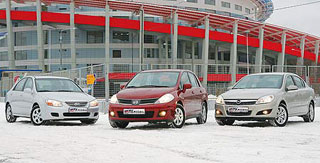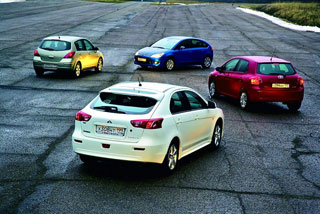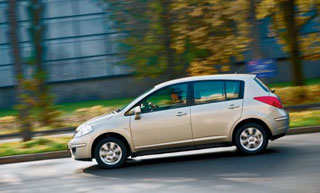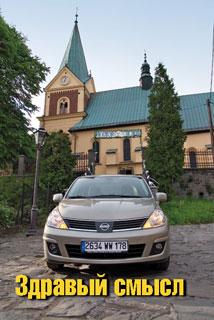Test drive Nissan Tiida (Versa) Sedan since 2006 sedan
Danes of fashion
 Golf class sedans retain stable positions in developing markets. And since there is a demand, there is a proposal. Presenting Nissan Tiida, the Japanese did not forget about the four -door version. Opel Astra manufacturers could not resist the temptation. And the company will make up the newcomers in this test that has already settled in Russia Korean Kia Cerato.
Golf class sedans retain stable positions in developing markets. And since there is a demand, there is a proposal. Presenting Nissan Tiida, the Japanese did not forget about the four -door version. Opel Astra manufacturers could not resist the temptation. And the company will make up the newcomers in this test that has already settled in Russia Korean Kia Cerato. Unlike the true Korean Cerato, compact Opel and Nissan are a German and Japanese only by name. Astra sedan is produced in Poland, and the European version of Tiida in Mexico. But these are the laws of globalization.
It would seem that it is possible to establish the production of cars for Europe, for example, at the existing factory in the UK. But, firstly, the planned sales volumes are relatively small 25,000 per year, and secondly, the model is addressed only to the peripheral markets of the Eastern European countries, the Baltic states and to us with Ukraine. So it turns out that taking cars from Mexico is cheaper.
However, God with him, with origin. The main thing is not where the car is made, but how. Of course, you can argue about the design and quality of the finishing materials of a particular model (say, the interior of Cerato is clearly more modest than competitors), but there are no complaints about all three participants in the test. There were no serious complaints in terms of ergonomics: the driver’s places are organized quite decent, and a person can get a job with acceptable comfort of almost any height and complexion. Although the author of these lines was best felt behind the Astra stall: the seat here has, perhaps, the optimal profile and rigidity, and the steering column is tuned not only in height (like two other cars), but also in departure. But the wide Tiida chair will willingly accept even the most oversized driver. And the central location of the adjusting handles eliminates the need to grop them in a narrow slit between the door and the seat pillow. You can’t refuse comfort and Cerato.
The driver's seat, equipped with height adjustment, is quite hard and distributes the loads well.
Our heroes are quite loyal to passengers. It is not surprising: the Opel sedan was created on the elongated Astra Caravan platform, which provides it with a record in this test of a 2703 mm wheelbase.
Tiida has this indicator 10 cm smaller, but the position is saved by a vertical landing (though, despite the high roof, tall passengers support the ceiling with their heads). The most closely, perhaps, in Cerato. But here, even here, the supply of space for legs allows even a person with a ninety meter to fit himself. The width of the salons is such that three adults can also sit in a dense group. And for two are generally expanse. Especially in Astra and Tiida, where you can remove a cozy armrest with cup holders from the back of the sofa.
Things are not bad with baggage transportation. The palm of the championship here again belongs to Opel: the luggage of Astra 490 liters. Tiida and Cerato compartments are slightly more modest 467 and 435 liters, respectively. If necessary, the useful volume can be increased by fully or partially folding the back of the rear sofa. The trunk open equally by the button from the cabin. But the most convenient to close the Cerato chest: in the peak of more eminent rivals, the inner handle was only in the Korean machine
Before moving on to the report on running tests, a couple of words about the choice of power units. The German sedan is available with 1.6 liter engines (115 hp) and 1.8 liters (140 hp), aggregated with a 5-speed manual gearbox. An alternative is an alternative to an alternative to an alternative to EasyTronic, and for a more powerful 4-band automato.
The Japanese competitor is offered with motors of the same volume, but their power is slightly lower than 110 and 126 hp. respectively. As a transmission for the 1.6 engine, ICP-5 or AKP-4 are available, and 1.8 is sold only with ICD-6.
Buyers of the Korean car can choose between a 1.6-liter 122-horsepower and 2-liter 143-horsepower versions. Each of them combines both a 5-speed mechanics and a 4-band machine.
Astra 1.8, Cerato 1.6 and Tiida 1.8 participated in this test (all with mechanical gearboxes).
It would seem that the most powerful engine should provide Opel unconditional leadership. He is really excellent. However, subjective assessments bring Nissan in the first place: the programs in the 6-speed box are selected very well, and the Tiida accelerator responds more freaks. A rather painful and rather quiet motor is equally well adapted to both the aggressive and unhurried manner of driving.
Cerato transmission is also well tuned (although the efforts on the KP lever were higher than the desired, and the clarity of turning on insufficient). But comfortable clutch takes from the bottom, and the moment engine allows you to start from almost any transmission. True, twisting the motor quickly bothers the vocabulary.
In general, the Korean does not at all provoke a quick ride. Although the chassis is adapted to a European way, and with small angles of rotation, the steering wheel provides intelligible feedback, Cerato reactions are not particularly accurate. In a steep turn for gas discharge, the car can easily go into skids. At the same time, the manufacturer does not offer any systems for maintaining the course stability.
Electronics will not come to the aid of Tiida: the ESP system is not available to Russian clients even as an option. Meanwhile, there is no reinforced concrete confidence in the behavior of the car. The steering electric power amplifier definitely lacks transparency. In tense turns, this is nervous.
Against the background of Astra rivals, it steer is noticeably better. And let the gourmets complain about the synthetic effort on the steering wheel in the connection between the car and the driver here is the best in the Trinity. At least the reactions of the machine are accurate, and trajectory deviations when passing irregularities in the turns are minimal.
Although, in general, the smoothness of the Opel course leaves much to be desired. The suspension reacts rigidly to the joints and minor defects of the coating, does not complain of bedridled policemen. The Korean sedan walks in the middle peasants. And the leader in part of the Tiida riding comfort. The Japanese simply does not notice small flaws on the asphalt, and the large ones overcame the playful. You can only complain about the buildup arising on gentle waves.
However, all assessments of ergonomic indicators and running qualities are largely subjective. Objective, ultimately, only the price of the issue. We’ll talk about her.
The most affordable car in our trinity Cerato. A sedan with an engine of 1.6 and ICP-5 costs from 439,000 rubles. At the same time, the machine is well equipped in the basic configuration: the steering wheel, front electric windows, air conditioning, two airbags, ABS.
The Japanese sedan, of course, is more expensive from 479,900 rubles for 1.6 and μP-5. But the level of initial configuration here is higher: full electric package, heating seats, radio tape recorders with Bluetooth, four airbags, ABS with EBD and Brake Assist. No, however, air conditioning.
Well, most of all you will have to lay out for Opel Astra. A car with a 1.6 liter and μP-5 engine was estimated at 497,000 rubles. Unlike Tiida, air conditioning is already present in the database (there are four airbags with ABS). However, for the radio, heating the seats and the rear electric windows will have to pay extra.
Interestingly, a comparison of car prices in maximum trim levels gives a completely different alignment. For the most expensive Tiida sedan, dealers ask for 600 900 rubles. The top version of Astra with a 1.8-liter engine and a four-speed automatic will facilitate a pocket for almost 670,000 rubles. Well, the fully equipped Cerato 2.0 and AKP-4 will cost 676,000 rubles.
Here you have cheap Koreans!
Kras-test Kia Cerato
In a series of crash tests conducted by Euroncap in 2006, Kia Cerato showed rather mediocre results. In particular, for the front test, the car received only 10 points. Experts had questions for the design of the front panel and to the pedal node that was displayed at the time of collision. In addition, the passenger sensors registered a significant excess of the load from the seat belt. The lateral test was also made by only 8 points.
As a result, the car received only 19 points, which corresponds to three rating stars.
Nissan Tiida crash test
In 2005, the Krash test tests of our Nissan Tiida market held the Japanese Nasva Automobile Security Agency. The frontal blow to the unfamily barrier showed that the car provides its passengers with a sufficient level of protection (89% and 72% for the driver and the front passenger). Typically, with a frontal impact with a displacement, the results remained practically unchanged (87% and 95%, respectively). With a lateral strike of the Tiida protection system, the car received the maximum possible assessment.
Crash test Opel Astra
In a series of crash tests, EURONCAP HESTRAK Opel Astra was an assessment of five stars, having earned 34 points. The front test was made by him at 14 points. Experts noted the good work of all standard security systems, but at the same time drew attention to the exceeding the driver’s chest, which could lead to a fracture of the ribs. For a side blow, the car received 16 points, and then there were no comments. The safety of children located in the cabin (4 stars out of 5) was no less highly appreciated, however, only 3 points received for loyalty to pedestrians.
Kia Cerato
+ A good price ratio, a rather spacious interior, a powerful 1.6-liter motor, a convenient climate control unit.
Mediocre noise insulation, fuzzy mechanism for choosing transmissions in the manual transmission, a rather high price in good configuration.
Nissan Tiida
+ Spacious salon, generous basic equipment, a painful engine, high smoothness.
Lack of adjustment of the steering wheel, pushing the seat profile, a large step between the trunk and the salon.
Opel Astra
+ Good controllability, a wide selection of transmission, space in the rear seats, roomy trunk.
The low smoothness of the course, relatively poorly basic equipment, is inconveniently organized by the control of the climate system.
Andrey Tsybulsky
Photo: Yan Segal
Source: Mkobil magazine [December/2007]








